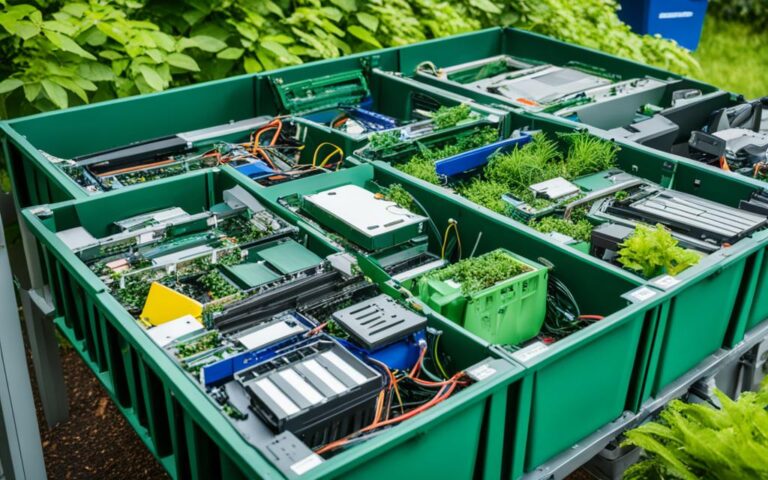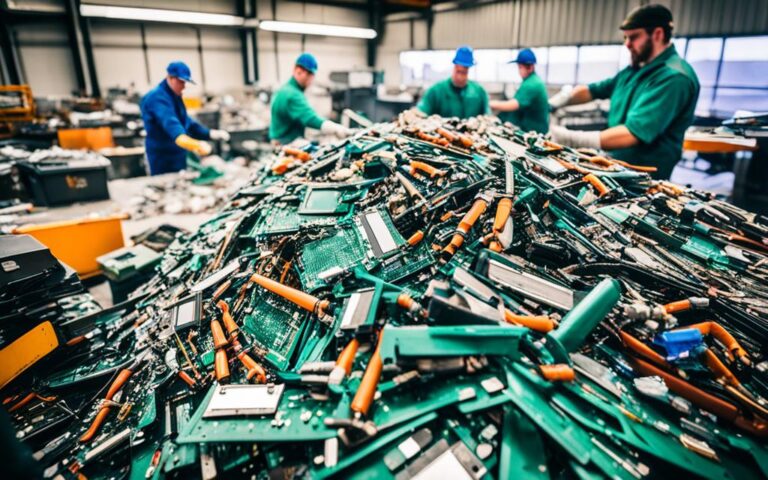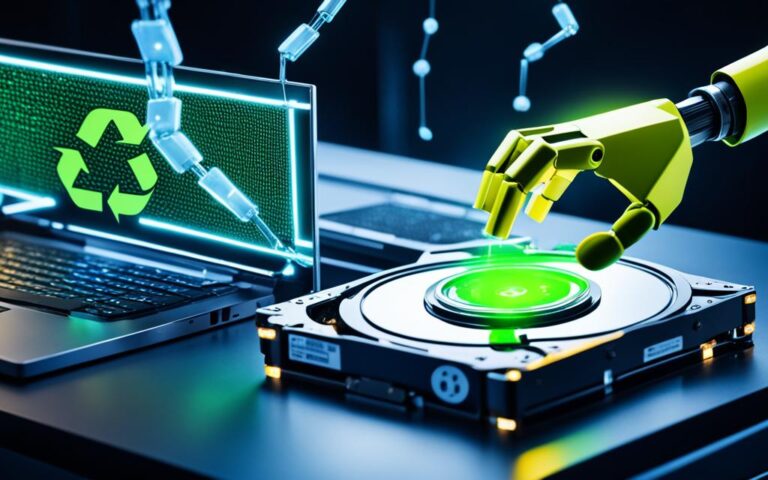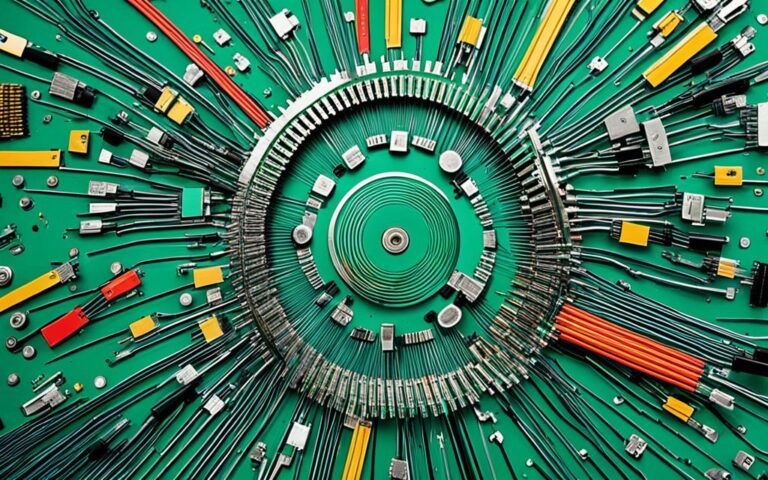Elevating Sustainability: The Role of Computer Hardware Upcycling
Computer hardware upcycling is an innovative approach to sustainability in the circular economy. It involves transforming waste materials from computer hardware into new products of higher value, reducing the need for new raw materials and diverting waste from landfills. This practice plays a significant role in advancing sustainability efforts within the UK’s tech industry.
As the demand for technology continues to grow, so does the environmental impact of the tech industry. From the extraction of raw materials to the disposal of electronic waste, the lifecycle of computer hardware takes a toll on the planet. That’s where computer hardware upcycling comes in. By repurposing and reimagining old components, we can give them a new lease of life and reduce their impact on the environment.
Through computer hardware upcycling, companies in the UK tech industry are finding innovative solutions to address sustainability challenges. By adopting circular economy principles, they can create a more sustainable future while still meeting the demand for new technology.
Upcycling and Repurposing Materials
Upcycling and repurposing materials is a key strategy in the circular economy. This practice involves taking waste materials and transforming them into new products that have higher value and functionality. By upcycling and repurposing, we can reduce waste, conserve resources, and contribute to environmental sustainability.
Startups in this space are at the forefront of driving the upcycling and repurposing movement. Companies such as TerraCycle, Bureo, Rothy’s, Looptworks, and Precious Plastic are leading the way in finding innovative ways to repurpose computer hardware and other materials. These startups are not only diverting waste from landfills but also creating new products that contribute to a more sustainable future.
By giving new life to old materials, upcycling and repurposing promote the principles of the circular economy. Instead of discarding items as waste, this approach encourages their transformation into valuable resources, extending their lifespan and reducing the overall environmental impact.
Through upcycling and repurposing, we can minimize the need for new raw materials, conserve energy, and reduce greenhouse gas emissions associated with resource extraction and production. This practice aligns with the goals of environmental sustainability and fosters creative solutions to address the challenges of waste management.
Pioneering Upcycling Startups
Let’s explore some of the pioneering startups in the field of upcycling and repurposing:
- TerraCycle: A company specializing in the recycling and upcycling of difficult-to-recycle materials, TerraCycle transforms items like chip bags, coffee capsules, and plastic packaging into new products.
- Bureo: Focused on ocean plastic pollution, Bureo collects discarded fishing nets and transforms them into high-quality products like skateboards and sunglasses.
- Rothy’s: Rothy’s repurposes single-use plastic water bottles into stylish and sustainable footwear for women.
- Looptworks: Looptworks repurposes excess materials from the fashion and textile industry, transforming them into unique accessories and apparel.
- Precious Plastic: Precious Plastic provides open-source tools and resources to empower individuals in creating their own upcycled products, fostering a community-driven approach to sustainability.
These startups are not only exemplifying the potential of upcycling and repurposing but also inspiring individuals and businesses to adopt more sustainable practices in their daily lives.
Environmental Impact of Upcycling and Repurposing
By diverting waste from landfills and transforming it into new products, upcycling and repurposing significantly reduce the environmental impact of waste disposal. Here are some key environmental benefits:
| Environmental Benefit | Description |
|---|---|
| Waste Reduction | By repurposing materials, upcycling reduces the volume of waste sent to landfills, minimizing the associated environmental and health risks. |
| Resource Conservation | By utilizing existing materials, upcycling reduces the demand for new raw materials, conserving natural resources such as timber, minerals, and fossil fuels. |
| Energy Savings | Upcycling requires less energy compared to traditional manufacturing processes, resulting in lower carbon emissions and decreased reliance on finite energy sources. |
| Water Conservation | The upcycling of materials like textiles reduces water consumption by minimizing the need for dyeing, washing, and other resource-intensive processes associated with producing new materials. |
By embracing upcycling and repurposing, we can contribute to the transition towards a more sustainable and circular economy. Startups and individuals alike have the power to make a significant positive impact on our environment through creative and innovative approaches to waste management and resource conservation.
Give New Life to Old Materials
Upcycling and repurposing involve giving new life to old materials that would otherwise be thrown away. This practice prolongs the lifespan of materials and reduces waste. By upcycling and repurposing, we can reduce the demand for new materials and minimize the environmental impact of resource extraction and production.
Examples of upcycling include:
- Transforming plastic bottles into bags
- Repurposing glass jars into candle holders
- Turning old textiles into fashionable tote bags
Through creativity and innovation, we can transform seemingly worthless items into valuable, functional products. Upcycling not only reduces waste but also encourages a shift towards a circular economy, where resources are kept in use for as long as possible.
Transforming Plastic Bottles into Bags
Plastic bottles are one of the most common items found in landfills, taking hundreds of years to decompose. However, with upcycling, these bottles can be transformed into durable and stylish bags. By cutting, weaving, and repurposing the plastic, we can create new products that help reduce the demand for single-use plastic and contribute to waste reduction.
Repurposing Glass Jars into Candle Holders
Empty glass jars, such as those previously used for food storage, can be given a new purpose as candle holders. By adding a wick and filling the jar with soy or beeswax, we can create eco-friendly candles that emit a warm and inviting glow. This repurposing not only reduces waste but also adds a touch of charm and uniqueness to our living spaces.
Turning Old Textiles into Fashionable Tote Bags
Old textiles, such as worn-out jeans or discarded curtains, can be transformed into fashionable tote bags. By repurposing these fabrics, we not only divert them from landfills but also create sustainable alternatives to single-use plastic bags. These upcycled tote bags can be stylish and functional, providing a fashionable way to reduce waste and promote sustainable fashion.
Through upcycling and repurposing, we can unlock the hidden potential of old materials and contribute to a more sustainable future. Instead of discarding items as waste, let’s embrace the circular economy and find creative ways to give them new life.
Upcycled Furniture and Fashion
Upcycling extends to furniture and fashion, offering creative ways to repurpose old materials. Companies like “Reclaimed Wood Designs” specialize in creating unique furniture pieces from reclaimed wood, while “ReFibered” transforms textile waste into stylish clothing items. Upcycled furniture and fashion not only reduce waste but also promote sustainable design and innovation. By choosing upcycled products, consumers can support the circular economy and minimize their environmental footprint.
Upcycling has gained significant popularity in the furniture and fashion industries as a means of creating sustainable and unique products. Rather than disposing of old materials and contributing to waste, designers and makers are turning to upcycling to give these materials a new lease on life.
Elevating Interior Design with Upcycled Furniture
Reclaimed Wood Designs is at the forefront of the upcycled furniture movement, showcasing the beauty and craftsmanship that can be achieved with reclaimed wood. Their artisans transform discarded wooden pallets, barn doors, and salvaged timber into stunning furniture pieces that add character and warmth to any space.
By repurposing old wood, Reclaimed Wood Designs not only reduces the demand for newly sourced timber but also prevents perfectly usable materials from ending up in landfills. Each piece tells a story, with unique markings and textures that can only be found in reclaimed wood.
| Furniture Piece | Description |
|---|---|
| Upcycled Wooden Dining Table | Handcrafted from reclaimed barn doors, this dining table showcases the rich history and natural beauty of aged wood. The distressed finish and sturdy construction make it a centerpiece for memorable meals. |
| Reclaimed Wood Coffee Table | A conversation starter in any living room, this coffee table features a mosaic of reclaimed timber pieces artfully arranged to form a captivating pattern. The expert craftsmanship ensures durability and longevity. |
| Upcycled Wood Bench | Constructed from salvaged pallets, this bench combines functionality with rustic charm. Each plank tells a story of its previous life, making it an eco-friendly and unique addition to any outdoor or indoor space. |
Repurposing Textiles into Fashion Statements
In the world of fashion, ReFibered is leading the charge in transforming textile waste into stylish and sustainable clothing items. By upcycling discarded fabric scraps and post-consumer textiles, they create fashion-forward designs that reduce waste and promote responsible consumption.
ReFibered partners with local artisans and seamstresses who carefully handcraft each garment, ensuring that every piece is of the highest quality. From upcycled denim jackets to tote bags made from repurposed curtains, their collection offers an eco-conscious alternative to fast fashion.
| Fashion Item | Description |
|---|---|
| Upcycled Denim Jacket | This trendy denim jacket is made from repurposed jeans, giving it a unique and edgy look. With its distressed details and timeless style, it’s a wardrobe staple that makes a statement while reducing textile waste. |
| Reclaimed Curtain Tote Bag | Turn heads with this eye-catching tote bag made from upcycled curtains. Its vibrant colors, sturdy construction, and spacious interior make it the perfect accessory for both fashion and function. |
| Repurposed Textile Dress | Designed with elegance and sustainability in mind, this dress is crafted from repurposed fabric remnants. The flowy silhouette and intricate patterns highlight the beauty of upcycled textiles while minimizing environmental impact. |
Upcycled furniture and fashion not only contribute to waste reduction but also serve as a testament to the power of sustainable design. By supporting companies like Reclaimed Wood Designs and ReFibered, consumers can make a positive impact on the environment while embracing unique and eco-friendly products.
Conclusion
Computer hardware upcycling is a crucial element in driving sustainability within the UK’s tech industry. By repurposing and upcycling materials, we have the ability to reduce waste, conserve valuable resources, and minimize our environmental impact. Through the efforts of innovative startups and businesses, upcycled products with enhanced value and functionality are being created, promoting a circular economy.
Embracing upcycling and adopting a circular lifestyle are integral steps towards building a sustainable future. By choosing upcycled products and contributing to the circular economy, individuals and businesses can actively participate in reducing their carbon footprint and promoting environmental responsibility.
Computer hardware upcycling not only diverts waste from landfills but also helps to decrease the demand for new raw materials. This practice positively affects the environment by conserving energy, reducing greenhouse gas emissions, and minimizing the degradation of natural resources. By upcycling and repurposing computer hardware, we are taking a proactive approach towards sustainability and making a substantial impact on the conservation of our planet.
As the importance of sustainability continues to be recognized and prioritized, computer hardware upcycling stands as a testament to the positive change that can be achieved in the tech industry and beyond. By championing upcycling practices and adopting a circular mindset, we can forge a path towards a more sustainable and environmentally conscious future for all.
FAQ
What is computer hardware upcycling?
Computer hardware upcycling is the process of transforming waste materials from computer hardware into new products of higher value. It contributes to sustainability efforts within the UK’s tech industry by reducing waste and the need for new raw materials.
How does upcycling and repurposing materials contribute to the circular economy?
Upcycling and repurposing materials are key strategies in the circular economy. They involve transforming waste materials into new products with higher value and functionality, reducing the demand for new materials and diverting waste from landfills.
Why is upcycling and repurposing important for environmental sustainability?
Upcycling and repurposing give new life to old materials, prolonging their lifespan and reducing waste. By transforming materials such as plastic bottles, glass jars, and textiles into new products, we can minimize the environmental impact of resource extraction and production.
What is the significance of upcycled furniture and fashion?
Upcycled furniture and fashion offer creative ways to repurpose old materials. Companies like “Reclaimed Wood Designs” specialize in creating unique furniture pieces from reclaimed wood, while “ReFibered” transforms textile waste into stylish clothing items. These products not only reduce waste but also promote sustainable design and innovation.
How does computer hardware upcycling contribute to sustainability efforts in the tech industry?
Computer hardware upcycling plays a vital role in elevating sustainability within the UK’s tech industry. By upcycling and repurposing materials from computer hardware, we can reduce waste, conserve resources, and minimize environmental impact. Innovative startups and businesses are leading the way in creating upcycled products of higher value and functionality.













